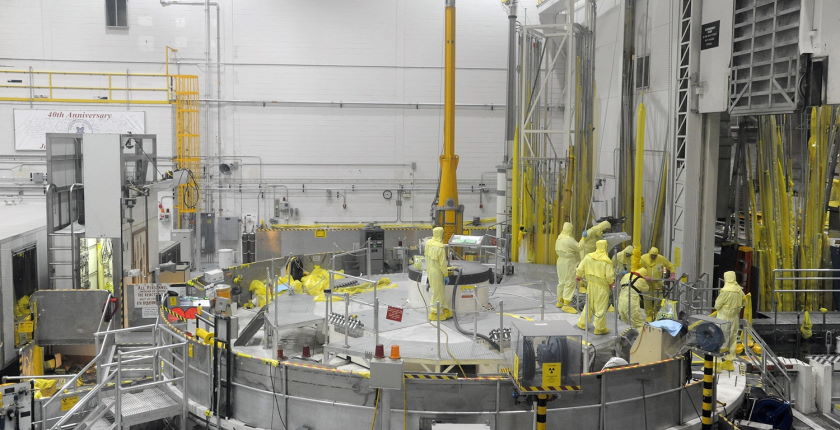
Photo: Courtesy Idaho National Laboratory
Small modular reactors, still an experimental technology, would create two to 30 times more radioactive waste in need of management and disposal per unit of energy than conventional nuclear plants, according to scientists from Stanford and the University of British Columbia.
With the onset of the energy crisis and Russia’s invasion of Ukraine in February, the governments of several European countries have started to promote small modular reactors or SMRs for energy security and hydrogen production needs. The developers of the technology are promising scalability, automation features, quicker and cheaper construction and enhanced safety measures.
Currently there is only a handful of pilot projects for small modular reactors around the world. Nuclear energy got a boost earlier this year in the European Union, which accepted it as a transitory solution on the path to net zero emissions in the power sector.
Eons of extended risk
But a new study released by Stanford and the University of British Columbia found SMRs would generate far more radioactive waste than conventional nuclear power plants. If confirmed, it could radically change the perception of the solution, being advertised as revolutionary.
Nuclear reactors generate reliable supplies of electricity with limited greenhouse gas emissions. Radioactive waste is another issue, as it must be isolated from the environment for hundreds of thousands of years.
Much of the benefits from nuclear plants’ low-carbon electricity generation are offset by high costs and the nuclear waste burden
The nuclear industry is developing small modular reactors, with under 300 MW of electric power. They can be assembled in factories. Industry analysts say these advanced modular designs will be cheaper and produce fewer radioactive byproducts than conventional large-scale reactors.
The new study indicates otherwise. “Our results show that most small modular reactor designs will actually increase the volume of nuclear waste in need of management and disposal, by factors of 2 to 30 for the reactors in our case study,” said lead author Lindsay Krall from Stanford.
Small modular reactors would boost radioactive waste pileup exponentially
About 440 nuclear reactors operate globally, providing approximately 10 percent of the world’s electricity. In the United States alone, commercial nuclear power plants have produced more than 88,000 metric tons of spent nuclear fuel, as well as substantial volumes of intermediate and low-level radioactive waste.
The most highly radioactive waste, mainly spent fuel, will have to be isolated in deep-mined geologic repositories. At present, the US has no program to develop a geologic repository, after spending decades and billions of dollars on the Yucca Mountain site in Nevada.
Remarkably few studies have analyzed the management and disposal of nuclear waste streams from small modular reactors
“Simple metrics, such as estimates of the mass of spent fuel, offer little insight into the resources that will be required to store, package, and dispose of the spent fuel and other radioactive waste,” said Krall, who is now a scientist at the Swedish Nuclear Fuel and Waste Management Co. “In fact, remarkably few studies have analyzed the management and disposal of nuclear waste streams from small modular reactors.”
For the study, Krall analyzed the nuclear waste streams from three types of small modular reactors being developed by Toshiba, NuScale and Terrestrial Energy, Stanford News reported.
Not only spent fuel is nuclear waste
Energy is produced in a nuclear reactor when a neutron splits a uranium atom in the reactor core, generating additional neutrons that go on to split other uranium atoms, creating a chain reaction. But some neutrons escape from the core and strike surrounding structural materials, such as steel and concrete, causing so-called neutron leakage and making the materials radioactive.
The new study found that, because of their smaller size, small modular reactors will experience more neutron leakage than conventional reactors.
“We found that small modular reactors will generate at least nine times more neutron-activated steel than conventional power plants. These radioactive materials have to be carefully managed prior to disposal, which will be expensive,” Ewing said.
Long-term radiation would be 50% higher
The study also found that the spent nuclear fuel from small modular reactors will be discharged in greater volumes per unit of energy extracted and can be far more complex than the spent fuel discharged from existing power plants.
“Some small modular reactor designs call for chemically exotic fuels and coolants that can produce difficult-to-manage wastes for disposal,” said co-author Allison Macfarlane from the University of British Columbia.
NuScale Power challenged the study, claiming it generates less waste than large reactors per unit of energy
One problem is long-term radiation from spent nuclear fuel. The research team estimated that after 10,000 years, the radiotoxicity of plutonium in spent fuels discharged from the three study modules would be at least 50 percent higher than the plutonium in conventional spent fuel per unit energy extracted.
Diane Hughes at NuScale Power challenged the study, arguing that the authors used obsolete data and that the company’s measure of waste generation compares favorably with large reactors, NewScientist reported.


















Be the first one to comment on this article.